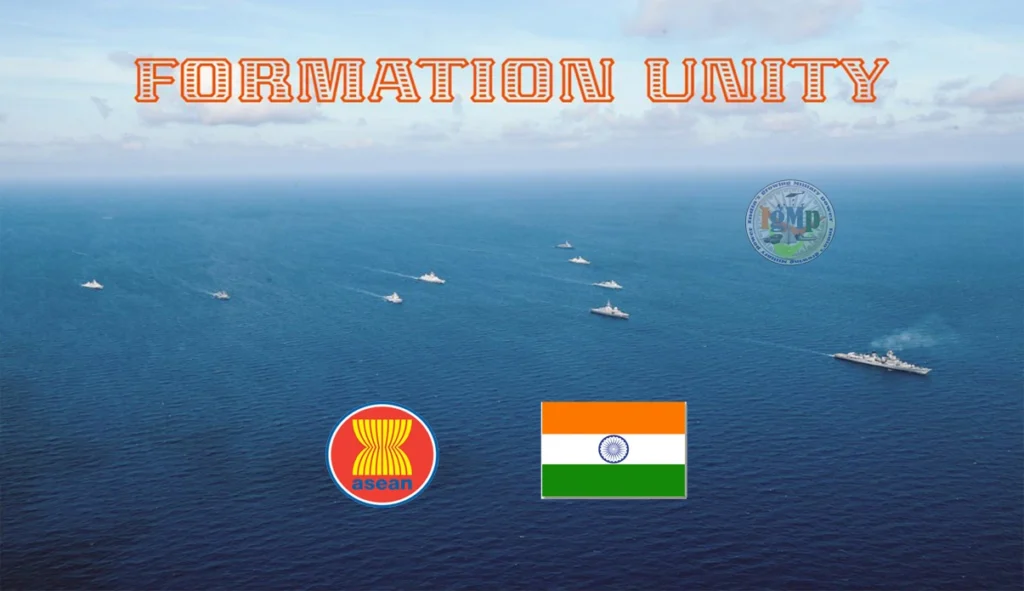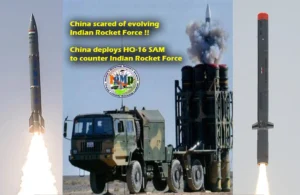Source : ABP News

Muscle Flexing In South China Sea: Why India-ASEAN War Games Send A Strong Signal To Beijing
The military might of India and ten ASEAN nations jointly displayed in South China Sea in the first week of May has rattled the Chinese security establishment. The Chinese are worried, not because of a few warships playing war games in its maritime vicinity, but because of India’s diplomatic success in generating consensus among ASEAN members to exercise together with an agenda to ensure peace, security and stability in the South China Sea with the assertion to keep the maritime area free and open for international navigation. This is significant as ASEAN countries have not been able to agree on the Code of Conduct between China and ASEAN for the South China Sea region.
ASEAN has thus conveyed a subtle message to China through this naval extravaganza that it should not claim suzerainty over the maritime area and China should strictly follow the United Nations Convention on Law of the Sea (UNCLOS), to which China is a signatory, and which has been in force since 1983.
While India and ASEAN were engaged in naval war games, the Chinese sought to intimidate the ASEAN partners by sending Chinese naval militia near the exercise area. The Indian Navy kept a close watch on the Chinese naval ships, during the sea phase of the exercise on May 7-8. Amid intense debate among Indian and international strategic circle, on maintenance of peace, stability and freedom of navigation rights in the South China Sea, the muscle flexing by India and ASEAN navies on a very grand scale irked China. By playing multi-nation war games in the South China Sea, India together with the navies of ASEAN members sent a strong signal to China that the maritime area is an open sea, and military or civilian ships can traverse the region without reporting to any national authority.
Since the international community regards South China Sea to be open and free for navigation, the maritime area must be guided by UNCLOS, but China has been claiming some of the island territories of the coastal states. Till now, the Indian Navy was conducting bilateral exercise with ASEAN members like Vietnam, Singapore, Indonesia, Malaysia, Brunei, Thailand, Philippines etc, but this was the first time when India was able to bring all the ASEAN navies together. The way the Indian Navy succeeded in bringing all the ASEAN members to take part in the first ever India ASEAN joint maritime exercise can only be described as a masterstroke by Indian strategic planners. It shows that the entire 10-member ASEAN wants to have special strategic partnership with India, and simultaneously conveys a subtle message to China, which claims a large part of the international waters as its authority.
Though China has succeeded in creating a wedge among the ten ASEAN members through its cheque book diplomacy, the participation of ASEAN navies in the India-led, but hosted by the Singapore navy, maritime exercise signifies that ASEAN as a group is committed to the South China Sea remaining an international ocean, free of any country’s dominance over the maritime area.
Not only India, but all ASEAN states besides rest of the maritime trading nations have a deep interest in keeping the area free of control by any particular power. As China continues to assert its role over the maritime area, the US and other Western powers have upped the ante against China for its aggressive moves. China has drawn an imaginary line over major part of the South China Sea, calling it Nine-dash line, which includes the Indonesian Natuna island and adjoining maritime area. This has led to a dispute between China and Indonesia. China has also staked its claim over islands near the Philippine sea, and deploys its naval militia to deter Philippine naval ships and fishing boats from roaming in the area. Similarly, China has also contested over Islands belonging to Vietnam, Indonesia, Brunei etc.
Integrated Force To Promote Peace, Stability
According to an Indian Navy official, about 1,400 personnel manning nine warships participated in the sea phase of the multilateral naval exercise. India’s indigenously designed and built ships-destroyer INS Delhi and stealth frigate INS Satpura, maritime patrol aircraft P8I and integral helicopters exercised with ASEAN naval ships from Brunei, Indonesia, Malaysia, Philippines, Singapore, Thailand and Vietnam. The two-day sea phase witnessed a wide spectrum of evolutions at sea, including tactical manoeuvres, cross-deck landings by helicopters, seamanship evolutions and other maritime operations. Apart from honing skills in the maritime domain the exercise enhanced interoperability and demonstrated the ability of Indian & ASEAN navies to operate as an integrated force to promote peace, stability and security in the region.
Significantly, Indian Naval Chief Admiral Hari Kumar also graced the landmark event and co-officiated the first ever ASEAN-India maritime exercise (AIME). The inaugural event was held at the Changi naval base of Singapore. The ceremony was jointly inaugurated by Adm R Hari Kumar and RAdm Sean Wat, Chief of Singapore Navy, in the presence of senior dignitaries from other ASEAN members.
According to the Indian Navy official quoted above, the AIME-23 was aimed at promoting maritime cooperation and enhancing trust, friendship and confidence amongst ASEAN and Indian Navies. The harbour phase at Singapore naval base from May 2 to 4 witnessed a range of professional and social interactions between the participating navies which included cross deck visits, Subject Matter Expert Exchanges (SMEE) and planning meetings. The official explained that the sea phase, which concluded on May 8 in the South China Sea, provided an opportunity for the participating navies to develop closer links in the coordination and execution of operations in the maritime domain. In practice, this means India is trying to create awareness and show significance of united action in the South China Sea in the event of a requirement.
The Indian Navy has also been closely interacting with individual ASEAN members in the high seas. As part of India’s vision of SAGAR (Security And Growth for All in the Region), the navy has been proactively engaging with the countries in the Indian Ocean Region towards enhancing regional maritime security. This has been achieved through bilateral and multilateral exercises, coordinated patrols, joint EEZ surveillance, and humanitarian assistance and disaster relief (HADR) operations. The Indian and ASEAN navies have enjoyed a close and friendly relationship covering a wide spectrum of activities and interactions, which have strengthened over the years.
These moves enhance the Indian Navy’s efforts to consolidate inter-operability and forge strong bonds of friendship between India and ASEAN members. India’s move is in tune with its Indo-Pacific policy of keeping the area safe, stable and peaceful and free of any country’s dominance. As a member of QUAD also, India has been raising its voice through this platform against the Chinese efforts to control the maritime area, which is vital for normal movement of Indian merchant ships, which transports more than half of Indian maritime trade. Muscle Flexing In South China Sea: Why India-ASEAN War Games Send A Strong Signal To Beijing Muscle Flexing In South China Sea: Why India-ASEAN War Games Send A Strong Signal To Beijing Muscle Flexing In South China Sea: Why India-ASEAN War Games Send A Strong Signal To Beijing Muscle Flexing In South China Sea: Why India-ASEAN War Games Send A Strong Signal To Beijing Muscle Flexing In South China Sea: Why India-ASEAN War Games Send A Strong Signal To Beijing Muscle Flexing In South China Sea: Why India-ASEAN War Games Send A Strong Signal To Beijing IgMp








